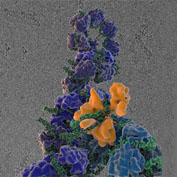
Flu viruses evolve rapidly, often staying one step ahead of efforts to vaccinate against infections or treat them with antiviral drugs. Work led by Jesse Bloom of the Fred Hutchinson Cancer Research Center has uncovered a surprising new flu mutation that allows influenza to infect cells in a novel way. Normally, a protein called hemagglutinin lets flu viruses attach to cells, and a protein called neuraminidase lets newly formed viruses escape from infected cells. Bloom’s lab has characterized a mutant flu virus where neuraminidase can enable the virus to attach to host cells even when hemagglutinin’s binding is blocked. Although the researchers generated the neuraminidase mutant studied in these experiments in their lab, the same mutation occurs naturally in strains from several recent flu outbreaks. There’s a possibility that flu viruses with such mutations may be able to escape antibodies that block the binding of hemagglutinin.
This work also was funded by NIH’s National Institute of Allergy and Infectious Diseases.
Learn more:

